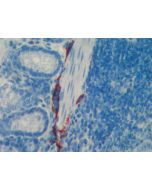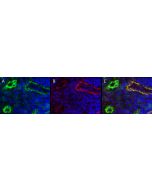Cookie Policy: This site uses cookies to improve your experience. You can find out more about our use of cookies in our Privacy Policy. By continuing to browse this site you agree to our use of cookies.
Chimerigen
LYVE-1 (mouse):Fc (mouse) (rec.)

| Product Details | |
|---|---|
| Synonyms | Lymphatic Vessel Endothelial Hyaluronan (HA) Receptor-1 |
| Product Type | Protein |
| Properties | |
| Source/Host | HEK 293 cells |
| Sequence |
The extracellular domain of mouse LYVE-1 (aa 24-228) is fused to the N-terminus of the Fc region of mouse IgG2a. |
| Crossreactivity | Mouse |
| MW | ~60-85kDa (SDS-PAGE) |
| Purity | ≥98% (SDS-PAGE) |
| Endotoxin Content | <1EU/mg protein (LAL test; Lonza). |
| Reconstitution | Reconstitute with 50 µl sterile water. Add 1X PBS to the desired protein concentration. |
| Formulation | Lyophilized from 0.2μm-filtered solution in PBS. |
| Protein Negative Control | |
| Other Product Data |
NCBI reference NP_444477.2: LYVE-1 (mouse) |
| Declaration | Manufactured by Chimerigen. |
| Shipping and Handling | |
| Shipping | BLUE ICE |
| Short Term Storage | +4°C |
| Long Term Storage | -20°C |
| Handling Advice |
Avoid freeze/thaw cycles. Centrifuge lyophilized vial before opening and reconstitution. |
| Use/Stability |
Stable for at least 1 year after receipt when stored at -20°C. Working aliquots are stable for up to 3 months when stored at -20°C. |
| Documents | |
| Product Specification Sheet | |
| Datasheet |
 Download PDF Download PDF |
Lymphatic Vessel Endothelial Hyaluronan (HA) Receptor-1 (LYVE-1) is a 60-kDa type I transmembrane glycoprotein that is a member of the Link Protein superfamily. HA is found in the extracellular matrix of most animal tissues and in body fluids. It modulates cell behavior and functions during tissue remodeling, development, homeostasis, and disease. It is often used as a marker of lymphatic endothelia. LYVE-1 is expressed on both the lumenal and ablumenal surfaces of lymphatic endothelium, and also on hepatic blood sinusoidal endothelia. This expression pattern, combined with studies showing that LYVE-1 can support cellular HA internalization in vitro, may suggest LYVE-1 participation in HA internalization for degradation, or transport of HA from tissues into the lumen of lymphatic vessels. LYVE-1-directed HA localization to lymphatic surfaces might also affect aspects of the immune response or tumor metastases. HA binding to CD44 can still occur in the presence of LYVE-1 in vitro. Therefore, LYVE-1-directed HA localization to lymphatics could provide a substrate for transmigrating CD44+ leukocytes or tumor cells. In addition to hepatic and lymphatic endothelia, some expression of LYVE-1 has been reported on Kupffer cells, the islets of Langerhans, cortical neurons, and renal epithelium.









